Analysis of PVD Improvement Methods for Soft Soils
VerifiedAdded on 2020/10/22
|13
|4331
|334
AI Summary
This assignment provides a detailed examination of different Pre-Loaded (PVD) improvement methods for soft soils. It includes case studies from countries such as China, Thailand, and Australia, along with laboratory experiments to assess the effectiveness of these techniques. The analysis covers various PVD applications, including vacuum consolidation, surcharge preloading, and combined loading methods. Additionally, it discusses the use of materials like cemented soil-tire chips mixtures for construction fills and feasibility studies on dredged slurries with wheat straw as drainage channels. The assignment aims to provide a comprehensive understanding of PVD improvements for soft soils.
Contribute Materials
Your contribution can guide someone’s learning journey. Share your
documents today.

CASE STUDY
Secure Best Marks with AI Grader
Need help grading? Try our AI Grader for instant feedback on your assignments.
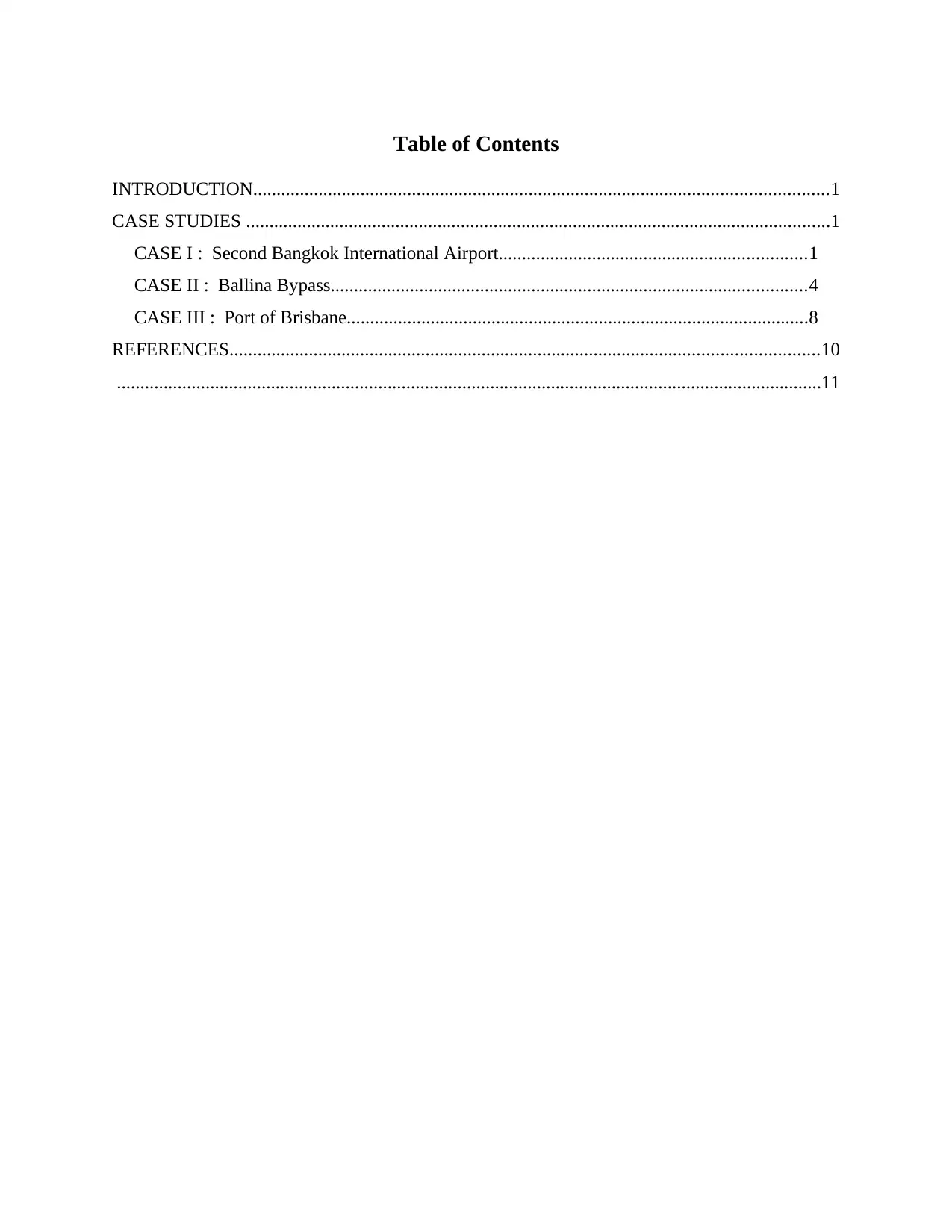
Table of Contents
INTRODUCTION...........................................................................................................................1
CASE STUDIES .............................................................................................................................1
CASE I : Second Bangkok International Airport..................................................................1
CASE II : Ballina Bypass......................................................................................................4
CASE III : Port of Brisbane...................................................................................................8
REFERENCES..............................................................................................................................10
.......................................................................................................................................................11
INTRODUCTION...........................................................................................................................1
CASE STUDIES .............................................................................................................................1
CASE I : Second Bangkok International Airport..................................................................1
CASE II : Ballina Bypass......................................................................................................4
CASE III : Port of Brisbane...................................................................................................8
REFERENCES..............................................................................................................................10
.......................................................................................................................................................11
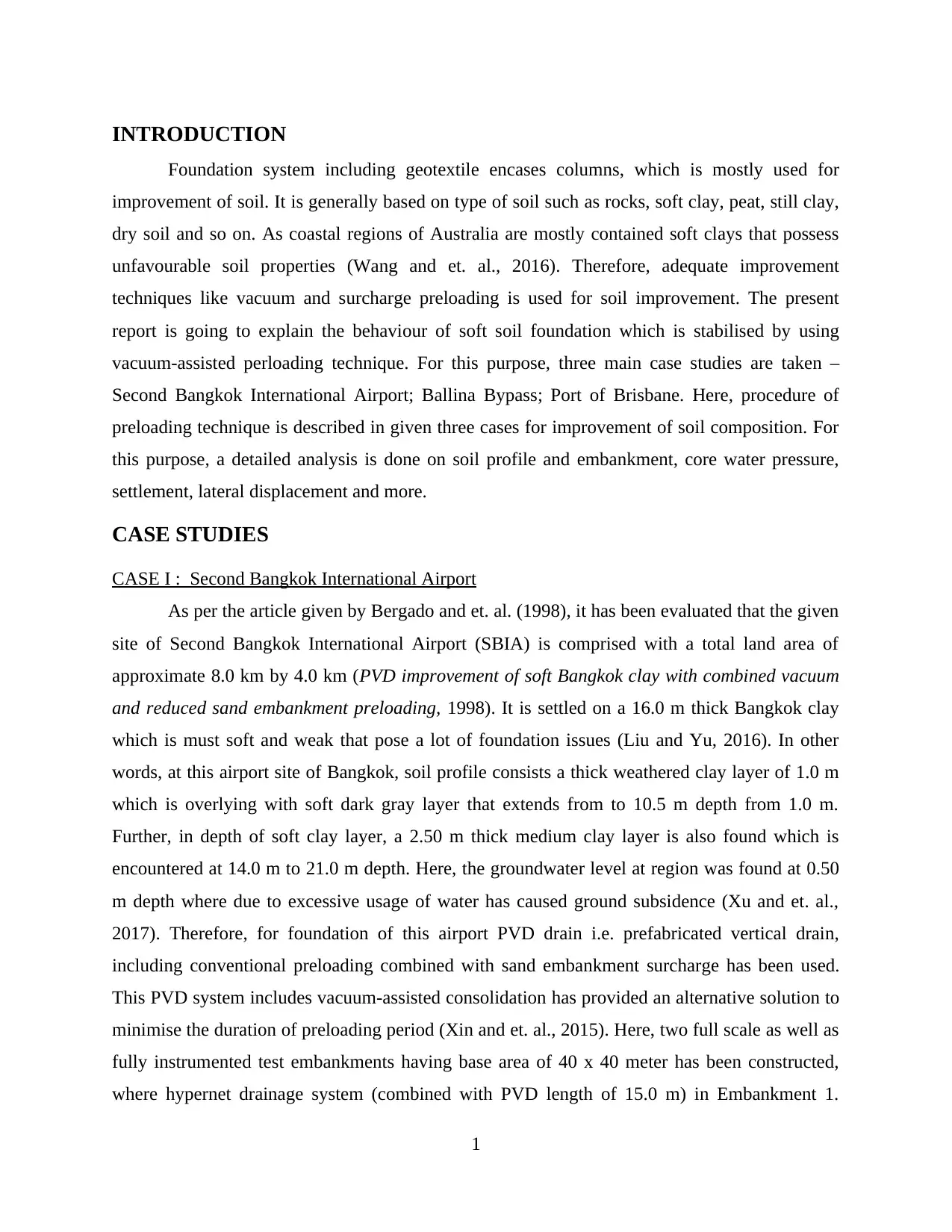
INTRODUCTION
Foundation system including geotextile encases columns, which is mostly used for
improvement of soil. It is generally based on type of soil such as rocks, soft clay, peat, still clay,
dry soil and so on. As coastal regions of Australia are mostly contained soft clays that possess
unfavourable soil properties (Wang and et. al., 2016). Therefore, adequate improvement
techniques like vacuum and surcharge preloading is used for soil improvement. The present
report is going to explain the behaviour of soft soil foundation which is stabilised by using
vacuum-assisted perloading technique. For this purpose, three main case studies are taken –
Second Bangkok International Airport; Ballina Bypass; Port of Brisbane. Here, procedure of
preloading technique is described in given three cases for improvement of soil composition. For
this purpose, a detailed analysis is done on soil profile and embankment, core water pressure,
settlement, lateral displacement and more.
CASE STUDIES
CASE I : Second Bangkok International Airport
As per the article given by Bergado and et. al. (1998), it has been evaluated that the given
site of Second Bangkok International Airport (SBIA) is comprised with a total land area of
approximate 8.0 km by 4.0 km (PVD improvement of soft Bangkok clay with combined vacuum
and reduced sand embankment preloading, 1998). It is settled on a 16.0 m thick Bangkok clay
which is must soft and weak that pose a lot of foundation issues (Liu and Yu, 2016). In other
words, at this airport site of Bangkok, soil profile consists a thick weathered clay layer of 1.0 m
which is overlying with soft dark gray layer that extends from to 10.5 m depth from 1.0 m.
Further, in depth of soft clay layer, a 2.50 m thick medium clay layer is also found which is
encountered at 14.0 m to 21.0 m depth. Here, the groundwater level at region was found at 0.50
m depth where due to excessive usage of water has caused ground subsidence (Xu and et. al.,
2017). Therefore, for foundation of this airport PVD drain i.e. prefabricated vertical drain,
including conventional preloading combined with sand embankment surcharge has been used.
This PVD system includes vacuum-assisted consolidation has provided an alternative solution to
minimise the duration of preloading period (Xin and et. al., 2015). Here, two full scale as well as
fully instrumented test embankments having base area of 40 x 40 meter has been constructed,
where hypernet drainage system (combined with PVD length of 15.0 m) in Embankment 1.
1
Foundation system including geotextile encases columns, which is mostly used for
improvement of soil. It is generally based on type of soil such as rocks, soft clay, peat, still clay,
dry soil and so on. As coastal regions of Australia are mostly contained soft clays that possess
unfavourable soil properties (Wang and et. al., 2016). Therefore, adequate improvement
techniques like vacuum and surcharge preloading is used for soil improvement. The present
report is going to explain the behaviour of soft soil foundation which is stabilised by using
vacuum-assisted perloading technique. For this purpose, three main case studies are taken –
Second Bangkok International Airport; Ballina Bypass; Port of Brisbane. Here, procedure of
preloading technique is described in given three cases for improvement of soil composition. For
this purpose, a detailed analysis is done on soil profile and embankment, core water pressure,
settlement, lateral displacement and more.
CASE STUDIES
CASE I : Second Bangkok International Airport
As per the article given by Bergado and et. al. (1998), it has been evaluated that the given
site of Second Bangkok International Airport (SBIA) is comprised with a total land area of
approximate 8.0 km by 4.0 km (PVD improvement of soft Bangkok clay with combined vacuum
and reduced sand embankment preloading, 1998). It is settled on a 16.0 m thick Bangkok clay
which is must soft and weak that pose a lot of foundation issues (Liu and Yu, 2016). In other
words, at this airport site of Bangkok, soil profile consists a thick weathered clay layer of 1.0 m
which is overlying with soft dark gray layer that extends from to 10.5 m depth from 1.0 m.
Further, in depth of soft clay layer, a 2.50 m thick medium clay layer is also found which is
encountered at 14.0 m to 21.0 m depth. Here, the groundwater level at region was found at 0.50
m depth where due to excessive usage of water has caused ground subsidence (Xu and et. al.,
2017). Therefore, for foundation of this airport PVD drain i.e. prefabricated vertical drain,
including conventional preloading combined with sand embankment surcharge has been used.
This PVD system includes vacuum-assisted consolidation has provided an alternative solution to
minimise the duration of preloading period (Xin and et. al., 2015). Here, two full scale as well as
fully instrumented test embankments having base area of 40 x 40 meter has been constructed,
where hypernet drainage system (combined with PVD length of 15.0 m) in Embankment 1.
1
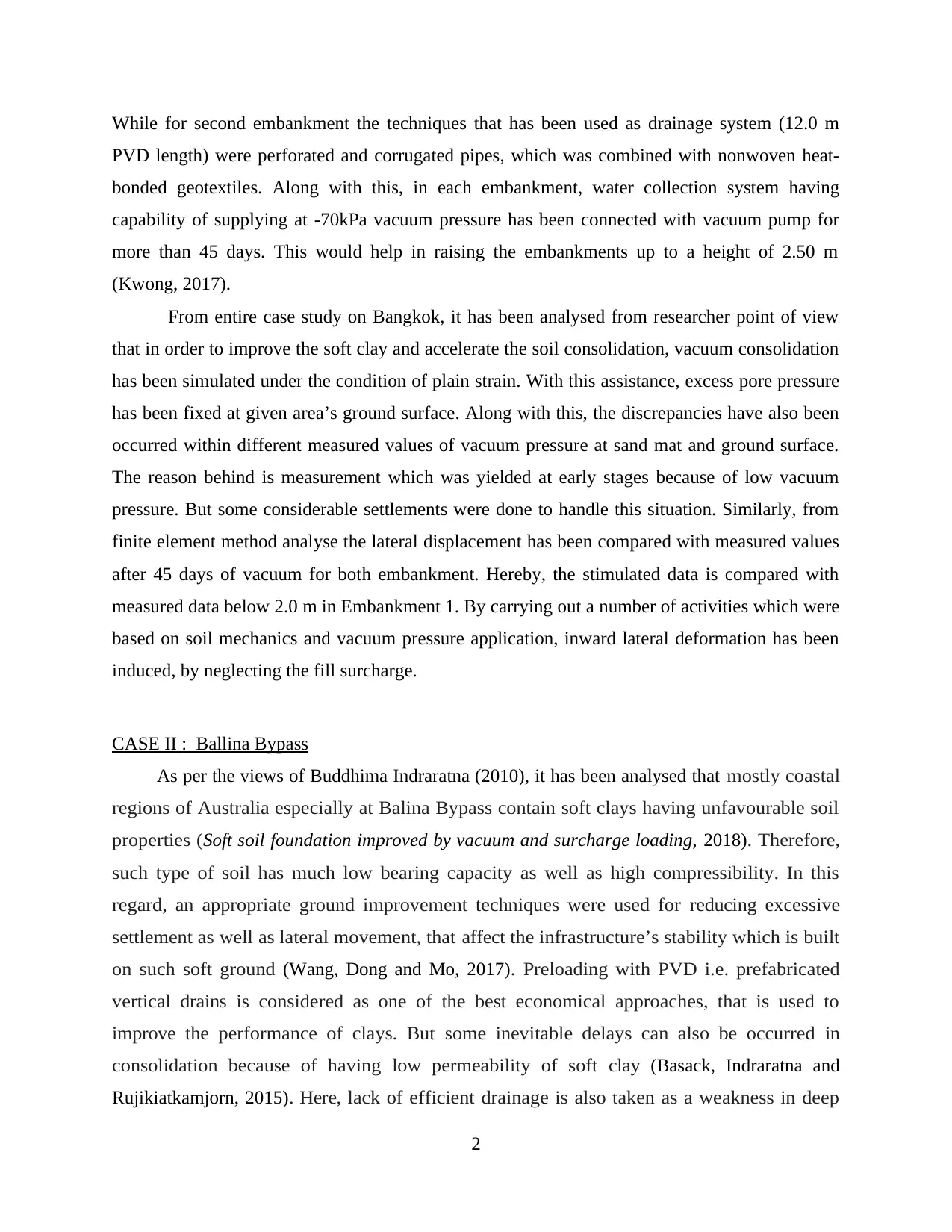
While for second embankment the techniques that has been used as drainage system (12.0 m
PVD length) were perforated and corrugated pipes, which was combined with nonwoven heat-
bonded geotextiles. Along with this, in each embankment, water collection system having
capability of supplying at -70kPa vacuum pressure has been connected with vacuum pump for
more than 45 days. This would help in raising the embankments up to a height of 2.50 m
(Kwong, 2017).
From entire case study on Bangkok, it has been analysed from researcher point of view
that in order to improve the soft clay and accelerate the soil consolidation, vacuum consolidation
has been simulated under the condition of plain strain. With this assistance, excess pore pressure
has been fixed at given area’s ground surface. Along with this, the discrepancies have also been
occurred within different measured values of vacuum pressure at sand mat and ground surface.
The reason behind is measurement which was yielded at early stages because of low vacuum
pressure. But some considerable settlements were done to handle this situation. Similarly, from
finite element method analyse the lateral displacement has been compared with measured values
after 45 days of vacuum for both embankment. Hereby, the stimulated data is compared with
measured data below 2.0 m in Embankment 1. By carrying out a number of activities which were
based on soil mechanics and vacuum pressure application, inward lateral deformation has been
induced, by neglecting the fill surcharge.
CASE II : Ballina Bypass
As per the views of Buddhima Indraratna (2010), it has been analysed that mostly coastal
regions of Australia especially at Balina Bypass contain soft clays having unfavourable soil
properties (Soft soil foundation improved by vacuum and surcharge loading, 2018) . Therefore,
such type of soil has much low bearing capacity as well as high compressibility. In this
regard, an appropriate ground improvement techniques were used for reducing excessive
settlement as well as lateral movement, that affect the infrastructure’s stability which is built
on such soft ground (Wang, Dong and Mo, 2017) . Preloading with PVD i.e. prefabricated
vertical drains is considered as one of the best economical approaches, that is used to
improve the performance of clays. But some inevitable delays can also be occurred in
consolidation because of having low permeability of soft clay (Basack, Indraratna and
Rujikiatkamjorn, 2015) . Here, lack of efficient drainage is also taken as a weakness in deep
2
PVD length) were perforated and corrugated pipes, which was combined with nonwoven heat-
bonded geotextiles. Along with this, in each embankment, water collection system having
capability of supplying at -70kPa vacuum pressure has been connected with vacuum pump for
more than 45 days. This would help in raising the embankments up to a height of 2.50 m
(Kwong, 2017).
From entire case study on Bangkok, it has been analysed from researcher point of view
that in order to improve the soft clay and accelerate the soil consolidation, vacuum consolidation
has been simulated under the condition of plain strain. With this assistance, excess pore pressure
has been fixed at given area’s ground surface. Along with this, the discrepancies have also been
occurred within different measured values of vacuum pressure at sand mat and ground surface.
The reason behind is measurement which was yielded at early stages because of low vacuum
pressure. But some considerable settlements were done to handle this situation. Similarly, from
finite element method analyse the lateral displacement has been compared with measured values
after 45 days of vacuum for both embankment. Hereby, the stimulated data is compared with
measured data below 2.0 m in Embankment 1. By carrying out a number of activities which were
based on soil mechanics and vacuum pressure application, inward lateral deformation has been
induced, by neglecting the fill surcharge.
CASE II : Ballina Bypass
As per the views of Buddhima Indraratna (2010), it has been analysed that mostly coastal
regions of Australia especially at Balina Bypass contain soft clays having unfavourable soil
properties (Soft soil foundation improved by vacuum and surcharge loading, 2018) . Therefore,
such type of soil has much low bearing capacity as well as high compressibility. In this
regard, an appropriate ground improvement techniques were used for reducing excessive
settlement as well as lateral movement, that affect the infrastructure’s stability which is built
on such soft ground (Wang, Dong and Mo, 2017) . Preloading with PVD i.e. prefabricated
vertical drains is considered as one of the best economical approaches, that is used to
improve the performance of clays. But some inevitable delays can also be occurred in
consolidation because of having low permeability of soft clay (Basack, Indraratna and
Rujikiatkamjorn, 2015) . Here, lack of efficient drainage is also taken as a weakness in deep
2
Paraphrase This Document
Need a fresh take? Get an instant paraphrase of this document with our AI Paraphraser
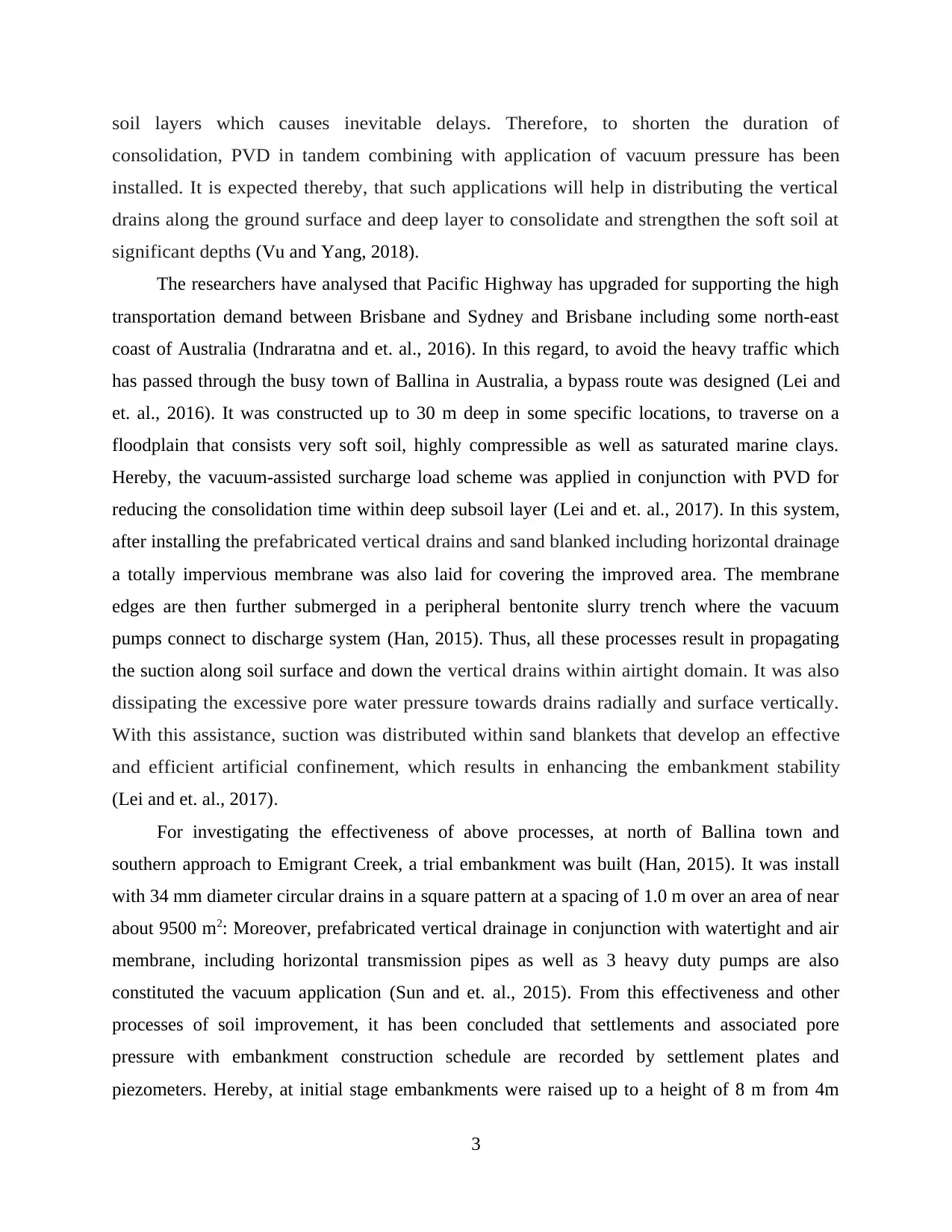
soil layers which causes inevitable delays. Therefore, to shorten the duration of
consolidation, PVD in tandem combining with application of vacuum pressure has been
installed. It is expected thereby, that such applications will help in distributing the vertical
drains along the ground surface and deep layer to consolidate and strengthen the soft soil at
significant depths (Vu and Yang, 2018) .
The researchers have analysed that Pacific Highway has upgraded for supporting the high
transportation demand between Brisbane and Sydney and Brisbane including some north-east
coast of Australia (Indraratna and et. al., 2016). In this regard, to avoid the heavy traffic which
has passed through the busy town of Ballina in Australia, a bypass route was designed (Lei and
et. al., 2016). It was constructed up to 30 m deep in some specific locations, to traverse on a
floodplain that consists very soft soil, highly compressible as well as saturated marine clays.
Hereby, the vacuum-assisted surcharge load scheme was applied in conjunction with PVD for
reducing the consolidation time within deep subsoil layer (Lei and et. al., 2017). In this system,
after installing the prefabricated vertical drains and sand blanked including horizontal drainage
a totally impervious membrane was also laid for covering the improved area. The membrane
edges are then further submerged in a peripheral bentonite slurry trench where the vacuum
pumps connect to discharge system (Han, 2015). Thus, all these processes result in propagating
the suction along soil surface and down the vertical drains within airtight domain. It was also
dissipating the excessive pore water pressure towards drains radially and surface vertically.
With this assistance, suction was distributed within sand blankets that develop an effective
and efficient artificial confinement, which results in enhancing the embankment stability
(Lei and et. al., 2017) .
For investigating the effectiveness of above processes, at north of Ballina town and
southern approach to Emigrant Creek, a trial embankment was built (Han, 2015). It was install
with 34 mm diameter circular drains in a square pattern at a spacing of 1.0 m over an area of near
about 9500 m2: Moreover, prefabricated vertical drainage in conjunction with watertight and air
membrane, including horizontal transmission pipes as well as 3 heavy duty pumps are also
constituted the vacuum application (Sun and et. al., 2015). From this effectiveness and other
processes of soil improvement, it has been concluded that settlements and associated pore
pressure with embankment construction schedule are recorded by settlement plates and
piezometers. Hereby, at initial stage embankments were raised up to a height of 8 m from 4m
3
consolidation, PVD in tandem combining with application of vacuum pressure has been
installed. It is expected thereby, that such applications will help in distributing the vertical
drains along the ground surface and deep layer to consolidate and strengthen the soft soil at
significant depths (Vu and Yang, 2018) .
The researchers have analysed that Pacific Highway has upgraded for supporting the high
transportation demand between Brisbane and Sydney and Brisbane including some north-east
coast of Australia (Indraratna and et. al., 2016). In this regard, to avoid the heavy traffic which
has passed through the busy town of Ballina in Australia, a bypass route was designed (Lei and
et. al., 2016). It was constructed up to 30 m deep in some specific locations, to traverse on a
floodplain that consists very soft soil, highly compressible as well as saturated marine clays.
Hereby, the vacuum-assisted surcharge load scheme was applied in conjunction with PVD for
reducing the consolidation time within deep subsoil layer (Lei and et. al., 2017). In this system,
after installing the prefabricated vertical drains and sand blanked including horizontal drainage
a totally impervious membrane was also laid for covering the improved area. The membrane
edges are then further submerged in a peripheral bentonite slurry trench where the vacuum
pumps connect to discharge system (Han, 2015). Thus, all these processes result in propagating
the suction along soil surface and down the vertical drains within airtight domain. It was also
dissipating the excessive pore water pressure towards drains radially and surface vertically.
With this assistance, suction was distributed within sand blankets that develop an effective
and efficient artificial confinement, which results in enhancing the embankment stability
(Lei and et. al., 2017) .
For investigating the effectiveness of above processes, at north of Ballina town and
southern approach to Emigrant Creek, a trial embankment was built (Han, 2015). It was install
with 34 mm diameter circular drains in a square pattern at a spacing of 1.0 m over an area of near
about 9500 m2: Moreover, prefabricated vertical drainage in conjunction with watertight and air
membrane, including horizontal transmission pipes as well as 3 heavy duty pumps are also
constituted the vacuum application (Sun and et. al., 2015). From this effectiveness and other
processes of soil improvement, it has been concluded that settlements and associated pore
pressure with embankment construction schedule are recorded by settlement plates and
piezometers. Hereby, at initial stage embankments were raised up to a height of 8 m from 4m
3
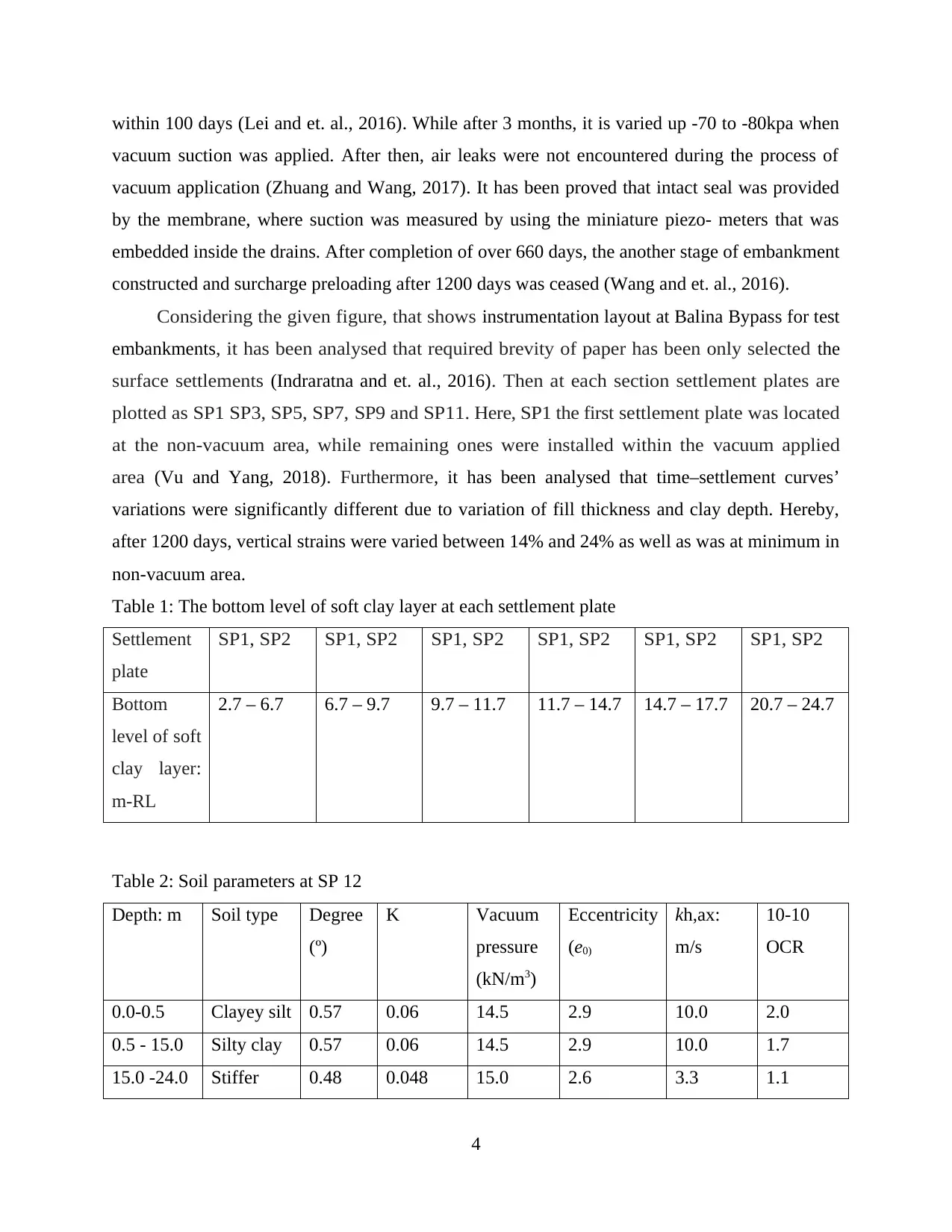
within 100 days (Lei and et. al., 2016). While after 3 months, it is varied up -70 to -80kpa when
vacuum suction was applied. After then, air leaks were not encountered during the process of
vacuum application (Zhuang and Wang, 2017). It has been proved that intact seal was provided
by the membrane, where suction was measured by using the miniature piezo- meters that was
embedded inside the drains. After completion of over 660 days, the another stage of embankment
constructed and surcharge preloading after 1200 days was ceased (Wang and et. al., 2016).
Considering the given figure, that shows instrumentation layout at Balina Bypass for test
embankments , it has been analysed that required brevity of paper has been only selected the
surface settlements (Indraratna and et. al., 2016) . Then at each section settlement plates are
plotted as SP1 SP3, SP5, SP7, SP9 and SP11. Here, SP1 the first settlement plate was located
at the non-vacuum area, while remaining ones were installed within the vacuum applied
area (Vu and Yang, 2018) . Furthermore, it has been analysed that time–settlement curves’
variations were significantly different due to variation of fill thickness and clay depth. Hereby,
after 1200 days, vertical strains were varied between 14% and 24% as well as was at minimum in
non-vacuum area.
Table 1: The bottom level of soft clay layer at each settlement plate
Settlement
plate
SP1, SP2 SP1, SP2 SP1, SP2 SP1, SP2 SP1, SP2 SP1, SP2
Bottom
level of soft
clay layer:
m-RL
2.7 – 6.7 6.7 – 9.7 9.7 – 11.7 11.7 – 14.7 14.7 – 17.7 20.7 – 24.7
Table 2: Soil parameters at SP 12
Depth: m Soil type Degree
(º)
K Vacuum
pressure
(kN/m3)
Eccentricity
(e0)
kh,ax:
m/s
10-10
OCR
0.0-0.5 Clayey silt 0.57 0.06 14.5 2.9 10.0 2.0
0.5 - 15.0 Silty clay 0.57 0.06 14.5 2.9 10.0 1.7
15.0 -24.0 Stiffer 0.48 0.048 15.0 2.6 3.3 1.1
4
vacuum suction was applied. After then, air leaks were not encountered during the process of
vacuum application (Zhuang and Wang, 2017). It has been proved that intact seal was provided
by the membrane, where suction was measured by using the miniature piezo- meters that was
embedded inside the drains. After completion of over 660 days, the another stage of embankment
constructed and surcharge preloading after 1200 days was ceased (Wang and et. al., 2016).
Considering the given figure, that shows instrumentation layout at Balina Bypass for test
embankments , it has been analysed that required brevity of paper has been only selected the
surface settlements (Indraratna and et. al., 2016) . Then at each section settlement plates are
plotted as SP1 SP3, SP5, SP7, SP9 and SP11. Here, SP1 the first settlement plate was located
at the non-vacuum area, while remaining ones were installed within the vacuum applied
area (Vu and Yang, 2018) . Furthermore, it has been analysed that time–settlement curves’
variations were significantly different due to variation of fill thickness and clay depth. Hereby,
after 1200 days, vertical strains were varied between 14% and 24% as well as was at minimum in
non-vacuum area.
Table 1: The bottom level of soft clay layer at each settlement plate
Settlement
plate
SP1, SP2 SP1, SP2 SP1, SP2 SP1, SP2 SP1, SP2 SP1, SP2
Bottom
level of soft
clay layer:
m-RL
2.7 – 6.7 6.7 – 9.7 9.7 – 11.7 11.7 – 14.7 14.7 – 17.7 20.7 – 24.7
Table 2: Soil parameters at SP 12
Depth: m Soil type Degree
(º)
K Vacuum
pressure
(kN/m3)
Eccentricity
(e0)
kh,ax:
m/s
10-10
OCR
0.0-0.5 Clayey silt 0.57 0.06 14.5 2.9 10.0 2.0
0.5 - 15.0 Silty clay 0.57 0.06 14.5 2.9 10.0 1.7
15.0 -24.0 Stiffer 0.48 0.048 15.0 2.6 3.3 1.1
4
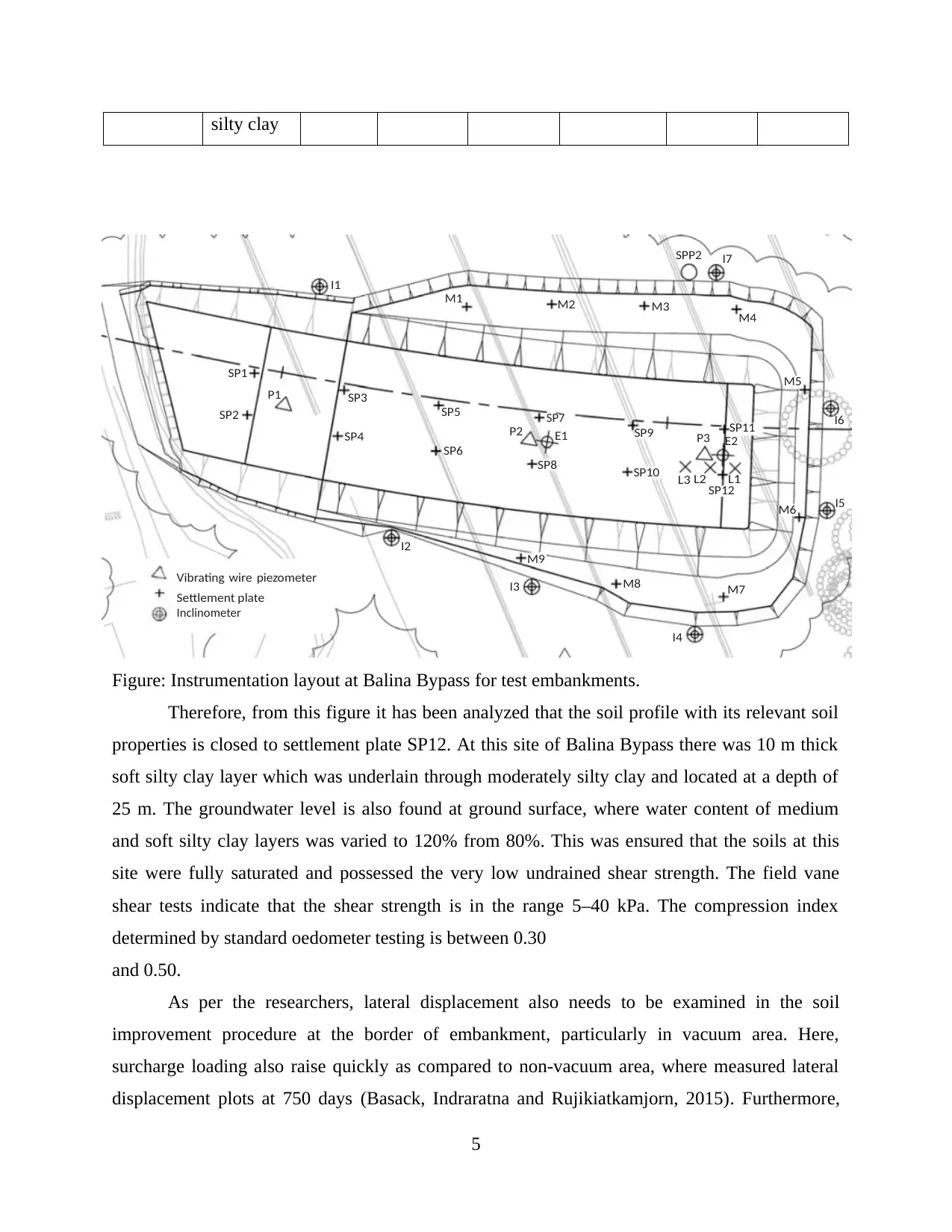
silty clay
Figure: Instrumentation layout at Balina Bypass for test embankments.
Therefore, from this figure it has been analyzed that the soil profile with its relevant soil
properties is closed to settlement plate SP12. At this site of Balina Bypass there was 10 m thick
soft silty clay layer which was underlain through moderately silty clay and located at a depth of
25 m. The groundwater level is also found at ground surface, where water content of medium
and soft silty clay layers was varied to 120% from 80%. This was ensured that the soils at this
site were fully saturated and possessed the very low undrained shear strength. The field vane
shear tests indicate that the shear strength is in the range 5–40 kPa. The compression index
determined by standard oedometer testing is between 0.30
and 0.50.
As per the researchers, lateral displacement also needs to be examined in the soil
improvement procedure at the border of embankment, particularly in vacuum area. Here,
surcharge loading also raise quickly as compared to non-vacuum area, where measured lateral
displacement plots at 750 days (Basack, Indraratna and Rujikiatkamjorn, 2015). Furthermore,
5
SPP2 I7
I1
M1 M2 M3 M4
SP1 M5
P1 SP3
SP2 SP5
SP4 P2
SP7
E1 SP9 P3
SP6
SP11
E2
I6
SP8 SP10 L3 L2 L1
SP12
M6 I5
I2 M9
Vibrating wire piezometer
Settlement plate
Inclinometer
I3 M8 M7
I4
Figure: Instrumentation layout at Balina Bypass for test embankments.
Therefore, from this figure it has been analyzed that the soil profile with its relevant soil
properties is closed to settlement plate SP12. At this site of Balina Bypass there was 10 m thick
soft silty clay layer which was underlain through moderately silty clay and located at a depth of
25 m. The groundwater level is also found at ground surface, where water content of medium
and soft silty clay layers was varied to 120% from 80%. This was ensured that the soils at this
site were fully saturated and possessed the very low undrained shear strength. The field vane
shear tests indicate that the shear strength is in the range 5–40 kPa. The compression index
determined by standard oedometer testing is between 0.30
and 0.50.
As per the researchers, lateral displacement also needs to be examined in the soil
improvement procedure at the border of embankment, particularly in vacuum area. Here,
surcharge loading also raise quickly as compared to non-vacuum area, where measured lateral
displacement plots at 750 days (Basack, Indraratna and Rujikiatkamjorn, 2015). Furthermore,
5
SPP2 I7
I1
M1 M2 M3 M4
SP1 M5
P1 SP3
SP2 SP5
SP4 P2
SP7
E1 SP9 P3
SP6
SP11
E2
I6
SP8 SP10 L3 L2 L1
SP12
M6 I5
I2 M9
Vibrating wire piezometer
Settlement plate
Inclinometer
I3 M8 M7
I4
Secure Best Marks with AI Grader
Need help grading? Try our AI Grader for instant feedback on your assignments.
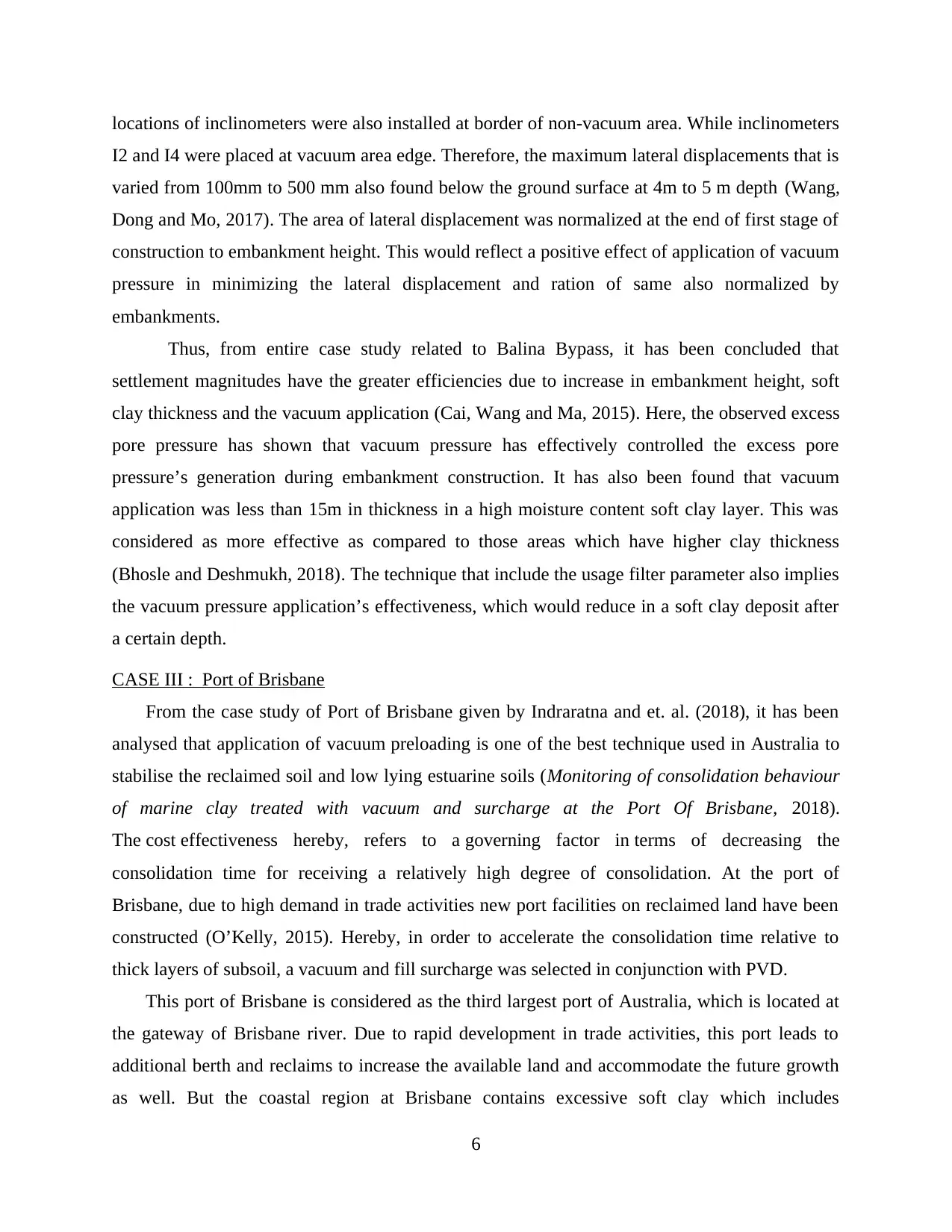
locations of inclinometers were also installed at border of non-vacuum area. While inclinometers
I2 and I4 were placed at vacuum area edge. Therefore, the maximum lateral displacements that is
varied from 100mm to 500 mm also found below the ground surface at 4m to 5 m depth (Wang,
Dong and Mo, 2017). The area of lateral displacement was normalized at the end of first stage of
construction to embankment height. This would reflect a positive effect of application of vacuum
pressure in minimizing the lateral displacement and ration of same also normalized by
embankments.
Thus, from entire case study related to Balina Bypass, it has been concluded that
settlement magnitudes have the greater efficiencies due to increase in embankment height, soft
clay thickness and the vacuum application (Cai, Wang and Ma, 2015). Here, the observed excess
pore pressure has shown that vacuum pressure has effectively controlled the excess pore
pressure’s generation during embankment construction. It has also been found that vacuum
application was less than 15m in thickness in a high moisture content soft clay layer. This was
considered as more effective as compared to those areas which have higher clay thickness
(Bhosle and Deshmukh, 2018). The technique that include the usage filter parameter also implies
the vacuum pressure application’s effectiveness, which would reduce in a soft clay deposit after
a certain depth.
CASE III : Port of Brisbane
From the case study of Port of Brisbane given by Indraratna and et. al. (2018), it has been
analysed that application of vacuum preloading is one of the best technique used in Australia to
stabilise the reclaimed soil and low lying estuarine soils (Monitoring of consolidation behaviour
of marine clay treated with vacuum and surcharge at the Port Of Brisbane, 2018).
The cost effectiveness hereby, refers to a governing factor in terms of decreasing the
consolidation time for receiving a relatively high degree of consolidation. At the port of
Brisbane, due to high demand in trade activities new port facilities on reclaimed land have been
constructed (O’Kelly, 2015). Hereby, in order to accelerate the consolidation time relative to
thick layers of subsoil, a vacuum and fill surcharge was selected in conjunction with PVD.
This port of Brisbane is considered as the third largest port of Australia, which is located at
the gateway of Brisbane river. Due to rapid development in trade activities, this port leads to
additional berth and reclaims to increase the available land and accommodate the future growth
as well. But the coastal region at Brisbane contains excessive soft clay which includes
6
I2 and I4 were placed at vacuum area edge. Therefore, the maximum lateral displacements that is
varied from 100mm to 500 mm also found below the ground surface at 4m to 5 m depth (Wang,
Dong and Mo, 2017). The area of lateral displacement was normalized at the end of first stage of
construction to embankment height. This would reflect a positive effect of application of vacuum
pressure in minimizing the lateral displacement and ration of same also normalized by
embankments.
Thus, from entire case study related to Balina Bypass, it has been concluded that
settlement magnitudes have the greater efficiencies due to increase in embankment height, soft
clay thickness and the vacuum application (Cai, Wang and Ma, 2015). Here, the observed excess
pore pressure has shown that vacuum pressure has effectively controlled the excess pore
pressure’s generation during embankment construction. It has also been found that vacuum
application was less than 15m in thickness in a high moisture content soft clay layer. This was
considered as more effective as compared to those areas which have higher clay thickness
(Bhosle and Deshmukh, 2018). The technique that include the usage filter parameter also implies
the vacuum pressure application’s effectiveness, which would reduce in a soft clay deposit after
a certain depth.
CASE III : Port of Brisbane
From the case study of Port of Brisbane given by Indraratna and et. al. (2018), it has been
analysed that application of vacuum preloading is one of the best technique used in Australia to
stabilise the reclaimed soil and low lying estuarine soils (Monitoring of consolidation behaviour
of marine clay treated with vacuum and surcharge at the Port Of Brisbane, 2018).
The cost effectiveness hereby, refers to a governing factor in terms of decreasing the
consolidation time for receiving a relatively high degree of consolidation. At the port of
Brisbane, due to high demand in trade activities new port facilities on reclaimed land have been
constructed (O’Kelly, 2015). Hereby, in order to accelerate the consolidation time relative to
thick layers of subsoil, a vacuum and fill surcharge was selected in conjunction with PVD.
This port of Brisbane is considered as the third largest port of Australia, which is located at
the gateway of Brisbane river. Due to rapid development in trade activities, this port leads to
additional berth and reclaims to increase the available land and accommodate the future growth
as well. But the coastal region at Brisbane contains excessive soft clay which includes
6

unfavourable geotechnical properties (Kwong, 2017). Hereby, soil profile includes high
compressibility layer of 30 m in thickness, combined with low undrain shear strength of 15kPa.
Therefore, lateral movement and an excessive settlement had posed an issue for stability of
structure that was built on this kind of ground covered with soft soil. In order to evaluate the
performance based on design and construction work between vacuum and fill preloading, three
contractors have been selected to be involved within this activity. As shown in below figure-
Contractor A: Here, process applied on over 8 trail areas in S3A having subdivision areas
which were designated as VC1, VC2, WD1, WD2, WD1, WD3, WD4s and WD5b. Here, areas
within WD1 to WD5 consist fill loading, whereas remaining areas VC1 and VC5 with fill
surcharge and vacuum consolidation through membrane system.
Contractor B: Here, a trial area include T11 having seven sub areas, whereby five among them
had a fill surcharge period combined with a variety of drain types. While remaining two areas
consist the fill surcharge period as well as vacuum with membraneless system.
7
compressibility layer of 30 m in thickness, combined with low undrain shear strength of 15kPa.
Therefore, lateral movement and an excessive settlement had posed an issue for stability of
structure that was built on this kind of ground covered with soft soil. In order to evaluate the
performance based on design and construction work between vacuum and fill preloading, three
contractors have been selected to be involved within this activity. As shown in below figure-
Contractor A: Here, process applied on over 8 trail areas in S3A having subdivision areas
which were designated as VC1, VC2, WD1, WD2, WD1, WD3, WD4s and WD5b. Here, areas
within WD1 to WD5 consist fill loading, whereas remaining areas VC1 and VC5 with fill
surcharge and vacuum consolidation through membrane system.
Contractor B: Here, a trial area include T11 having seven sub areas, whereby five among them
had a fill surcharge period combined with a variety of drain types. While remaining two areas
consist the fill surcharge period as well as vacuum with membraneless system.
7

Contractor C: This process has occupied the T11 area that was divided into areas with 4, 5 and
6 whereby 4th and 5th area have a fill period over 12 months and installed with 1.4m space.
While, 6th Area fill for 6 months that installed with vertical drains at 1m spacing.
It has been analysed that acceleration of soil consideration take more than 50 years
without preloading, with vertical deformation over 2.5 to 4.0 m for required service loading (Xin
and et. al., 2015). Therefore, vacuum application combined with PVD prefabricated vertical
drainage was used for accelerating the consolidation time, due to dredged mud having low shear
strength. Hereby, settlement plates depend on the reliability and accuracy of installed instruments
at Port of Brisbane. Since field instruments were composed with 32 settlement guages, 10
inclinometers and over 76 vibrating wire piezometers. Therefore, the another major factor that
was considered for selecting the type of instrument was the need for monitoring large soil
deformation. For this purpose, reliability as well as accuracy of installed instrument have been
determined through equipment manufacturers as shown in below table-
Table: Reliability and accuracy of installed instruments at Port of Brisbane
Instrument Accuracy Reliability indication
Heavy duty vibrating wire
piezometer
0.1 to - 0.1% full scale Over range capacity at 200%
full scale
Inclinometer Sensor with +0.02% to -0.02%
Full scale
Repeatability over +0.08% to -
0.08%
Hereby, usage of PVD and application of vacuum pressure has controlled the lateral movement
in some certain sensitive areas. It includes vicinity of marine parks, some sites at Ports of
Brisbane and more (Liu and Yu, 2016). On comparison of vacuum and non-vacuum areas the
lateral movements have consisted a variety of soil profile and surcharge load condition. Along
with this, lateral displacement has also divided through effective stress at variant depth.
The dimensionless β-factor is taken for considering the drain as well as site loading
conditions, regardless of soil profile for a given depth of soil. This parameter refers to most
useful parameter which can differentiate the effectiveness of above three techniques. For this
purpose, it captures the effects of increase in drain lengths (ld), reduce in drain spacing (Sd) and
patter of area (1.13 for square spacing and ᾰ = 1.05 for triangular). Along with this, H denotes
the surcharge load height and hc for given clay thickness. Thus, β can be defined as –
8
6 whereby 4th and 5th area have a fill period over 12 months and installed with 1.4m space.
While, 6th Area fill for 6 months that installed with vertical drains at 1m spacing.
It has been analysed that acceleration of soil consideration take more than 50 years
without preloading, with vertical deformation over 2.5 to 4.0 m for required service loading (Xin
and et. al., 2015). Therefore, vacuum application combined with PVD prefabricated vertical
drainage was used for accelerating the consolidation time, due to dredged mud having low shear
strength. Hereby, settlement plates depend on the reliability and accuracy of installed instruments
at Port of Brisbane. Since field instruments were composed with 32 settlement guages, 10
inclinometers and over 76 vibrating wire piezometers. Therefore, the another major factor that
was considered for selecting the type of instrument was the need for monitoring large soil
deformation. For this purpose, reliability as well as accuracy of installed instrument have been
determined through equipment manufacturers as shown in below table-
Table: Reliability and accuracy of installed instruments at Port of Brisbane
Instrument Accuracy Reliability indication
Heavy duty vibrating wire
piezometer
0.1 to - 0.1% full scale Over range capacity at 200%
full scale
Inclinometer Sensor with +0.02% to -0.02%
Full scale
Repeatability over +0.08% to -
0.08%
Hereby, usage of PVD and application of vacuum pressure has controlled the lateral movement
in some certain sensitive areas. It includes vicinity of marine parks, some sites at Ports of
Brisbane and more (Liu and Yu, 2016). On comparison of vacuum and non-vacuum areas the
lateral movements have consisted a variety of soil profile and surcharge load condition. Along
with this, lateral displacement has also divided through effective stress at variant depth.
The dimensionless β-factor is taken for considering the drain as well as site loading
conditions, regardless of soil profile for a given depth of soil. This parameter refers to most
useful parameter which can differentiate the effectiveness of above three techniques. For this
purpose, it captures the effects of increase in drain lengths (ld), reduce in drain spacing (Sd) and
patter of area (1.13 for square spacing and ᾰ = 1.05 for triangular). Along with this, H denotes
the surcharge load height and hc for given clay thickness. Thus, β can be defined as –
8
Paraphrase This Document
Need a fresh take? Get an instant paraphrase of this document with our AI Paraphraser

β = ( ld / Sd ᾰ) X (H/hc)
Therefore, through this calculation it has been concluded that there under Contractor A, there has
a low β impact for S3A. While, there has a moderate impact under Contractor B for T11 and
high for Contractor C. Henceforth, with reduce in pore water pressure it has been observed that
VC2 in S3A had the largest reduction that was as closely followed in T11 by VWP3. Whereas,
fill pressure has been decreased in vacuum areas of S3A which involves less fill operations as
shown in below figure-
Through numerically determination, it has been interpreted from above figure that there
was a similar behaviour in all procedure of treatment site. It results in separation between non-
vacuum and vacuum areas, that leads to separate the vacuum consolidation performance also
especially for A and B contractors.
From overall theory, it has been concluded that a system of vertical drains including
vacuum preloading is considered as best method to accelerate soil consolidation. By analysing
the performance of ground consolidation was analysed at Port of Brisbane (Xu and et. al., 2017).
For this assistance, three areas have been taken on trial basis to study the surcharge behaviour
and vacuum consolidation in improvement of soil at surface of ground. By comparison the three
techniques which were carried on different areas it has been analysed that first one i.e.
Contractor A was considered as most beneficial. Along with this, membraneless vacuum-assisted
system seems to be more effective on the basis of controlling lateral displacement. But this study
fails to give more details in the field of inclinometer data in order to make overall conclusion.
9
Text 1: Pore Water Pressure's excess rate for reduction in T11 and S3A
Therefore, through this calculation it has been concluded that there under Contractor A, there has
a low β impact for S3A. While, there has a moderate impact under Contractor B for T11 and
high for Contractor C. Henceforth, with reduce in pore water pressure it has been observed that
VC2 in S3A had the largest reduction that was as closely followed in T11 by VWP3. Whereas,
fill pressure has been decreased in vacuum areas of S3A which involves less fill operations as
shown in below figure-
Through numerically determination, it has been interpreted from above figure that there
was a similar behaviour in all procedure of treatment site. It results in separation between non-
vacuum and vacuum areas, that leads to separate the vacuum consolidation performance also
especially for A and B contractors.
From overall theory, it has been concluded that a system of vertical drains including
vacuum preloading is considered as best method to accelerate soil consolidation. By analysing
the performance of ground consolidation was analysed at Port of Brisbane (Xu and et. al., 2017).
For this assistance, three areas have been taken on trial basis to study the surcharge behaviour
and vacuum consolidation in improvement of soil at surface of ground. By comparison the three
techniques which were carried on different areas it has been analysed that first one i.e.
Contractor A was considered as most beneficial. Along with this, membraneless vacuum-assisted
system seems to be more effective on the basis of controlling lateral displacement. But this study
fails to give more details in the field of inclinometer data in order to make overall conclusion.
9
Text 1: Pore Water Pressure's excess rate for reduction in T11 and S3A

10
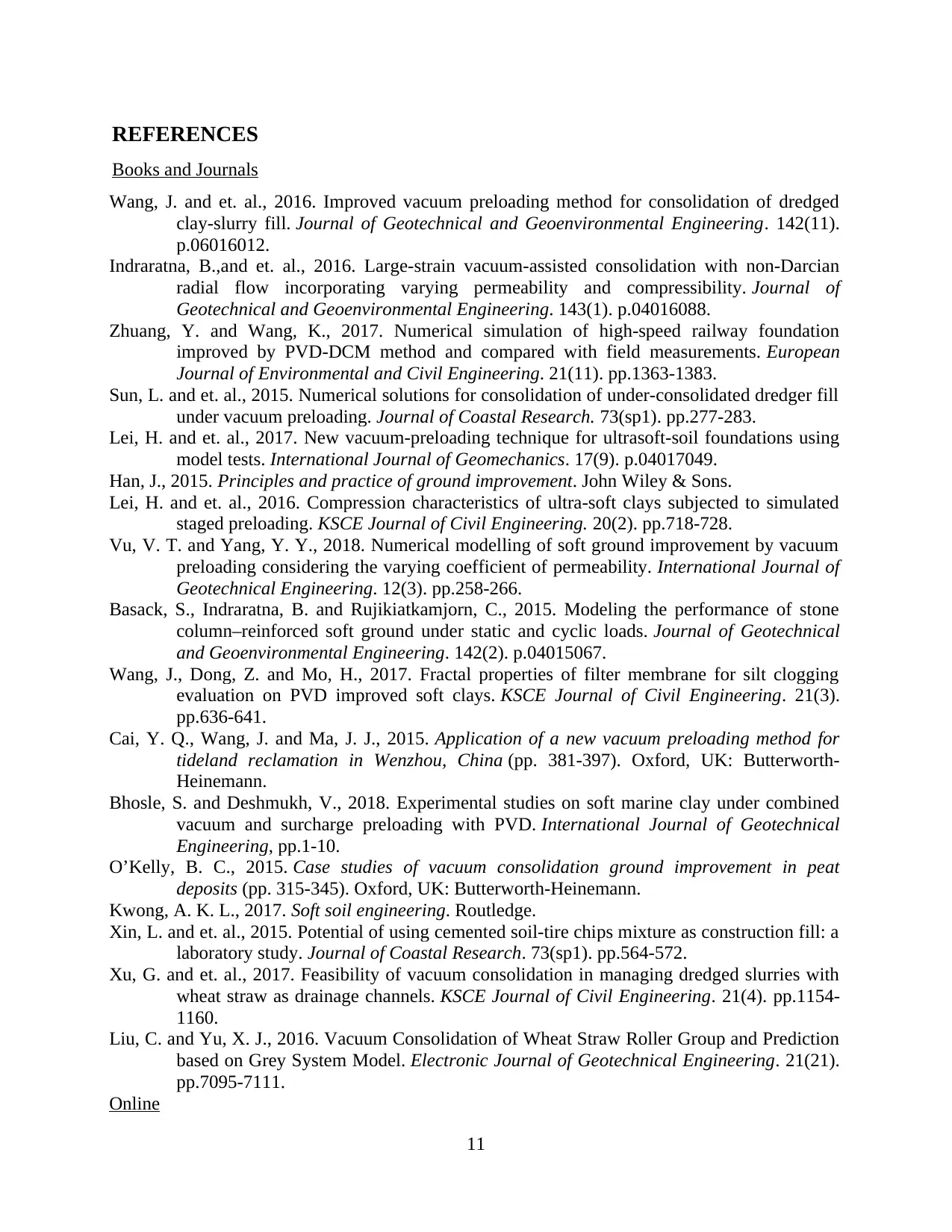
REFERENCES
Books and Journals
Wang, J. and et. al., 2016. Improved vacuum preloading method for consolidation of dredged
clay-slurry fill. Journal of Geotechnical and Geoenvironmental Engineering. 142(11).
p.06016012.
Indraratna, B.,and et. al., 2016. Large-strain vacuum-assisted consolidation with non-Darcian
radial flow incorporating varying permeability and compressibility. Journal of
Geotechnical and Geoenvironmental Engineering. 143(1). p.04016088.
Zhuang, Y. and Wang, K., 2017. Numerical simulation of high-speed railway foundation
improved by PVD-DCM method and compared with field measurements. European
Journal of Environmental and Civil Engineering. 21(11). pp.1363-1383.
Sun, L. and et. al., 2015. Numerical solutions for consolidation of under-consolidated dredger fill
under vacuum preloading. Journal of Coastal Research. 73(sp1). pp.277-283.
Lei, H. and et. al., 2017. New vacuum-preloading technique for ultrasoft-soil foundations using
model tests. International Journal of Geomechanics. 17(9). p.04017049.
Han, J., 2015. Principles and practice of ground improvement. John Wiley & Sons.
Lei, H. and et. al., 2016. Compression characteristics of ultra-soft clays subjected to simulated
staged preloading. KSCE Journal of Civil Engineering. 20(2). pp.718-728.
Vu, V. T. and Yang, Y. Y., 2018. Numerical modelling of soft ground improvement by vacuum
preloading considering the varying coefficient of permeability. International Journal of
Geotechnical Engineering. 12(3). pp.258-266.
Basack, S., Indraratna, B. and Rujikiatkamjorn, C., 2015. Modeling the performance of stone
column–reinforced soft ground under static and cyclic loads. Journal of Geotechnical
and Geoenvironmental Engineering. 142(2). p.04015067.
Wang, J., Dong, Z. and Mo, H., 2017. Fractal properties of filter membrane for silt clogging
evaluation on PVD improved soft clays. KSCE Journal of Civil Engineering. 21(3).
pp.636-641.
Cai, Y. Q., Wang, J. and Ma, J. J., 2015. Application of a new vacuum preloading method for
tideland reclamation in Wenzhou, China (pp. 381-397). Oxford, UK: Butterworth-
Heinemann.
Bhosle, S. and Deshmukh, V., 2018. Experimental studies on soft marine clay under combined
vacuum and surcharge preloading with PVD. International Journal of Geotechnical
Engineering, pp.1-10.
O’Kelly, B. C., 2015. Case studies of vacuum consolidation ground improvement in peat
deposits (pp. 315-345). Oxford, UK: Butterworth-Heinemann.
Kwong, A. K. L., 2017. Soft soil engineering. Routledge.
Xin, L. and et. al., 2015. Potential of using cemented soil-tire chips mixture as construction fill: a
laboratory study. Journal of Coastal Research. 73(sp1). pp.564-572.
Xu, G. and et. al., 2017. Feasibility of vacuum consolidation in managing dredged slurries with
wheat straw as drainage channels. KSCE Journal of Civil Engineering. 21(4). pp.1154-
1160.
Liu, C. and Yu, X. J., 2016. Vacuum Consolidation of Wheat Straw Roller Group and Prediction
based on Grey System Model. Electronic Journal of Geotechnical Engineering. 21(21).
pp.7095-7111.
Online
11
Books and Journals
Wang, J. and et. al., 2016. Improved vacuum preloading method for consolidation of dredged
clay-slurry fill. Journal of Geotechnical and Geoenvironmental Engineering. 142(11).
p.06016012.
Indraratna, B.,and et. al., 2016. Large-strain vacuum-assisted consolidation with non-Darcian
radial flow incorporating varying permeability and compressibility. Journal of
Geotechnical and Geoenvironmental Engineering. 143(1). p.04016088.
Zhuang, Y. and Wang, K., 2017. Numerical simulation of high-speed railway foundation
improved by PVD-DCM method and compared with field measurements. European
Journal of Environmental and Civil Engineering. 21(11). pp.1363-1383.
Sun, L. and et. al., 2015. Numerical solutions for consolidation of under-consolidated dredger fill
under vacuum preloading. Journal of Coastal Research. 73(sp1). pp.277-283.
Lei, H. and et. al., 2017. New vacuum-preloading technique for ultrasoft-soil foundations using
model tests. International Journal of Geomechanics. 17(9). p.04017049.
Han, J., 2015. Principles and practice of ground improvement. John Wiley & Sons.
Lei, H. and et. al., 2016. Compression characteristics of ultra-soft clays subjected to simulated
staged preloading. KSCE Journal of Civil Engineering. 20(2). pp.718-728.
Vu, V. T. and Yang, Y. Y., 2018. Numerical modelling of soft ground improvement by vacuum
preloading considering the varying coefficient of permeability. International Journal of
Geotechnical Engineering. 12(3). pp.258-266.
Basack, S., Indraratna, B. and Rujikiatkamjorn, C., 2015. Modeling the performance of stone
column–reinforced soft ground under static and cyclic loads. Journal of Geotechnical
and Geoenvironmental Engineering. 142(2). p.04015067.
Wang, J., Dong, Z. and Mo, H., 2017. Fractal properties of filter membrane for silt clogging
evaluation on PVD improved soft clays. KSCE Journal of Civil Engineering. 21(3).
pp.636-641.
Cai, Y. Q., Wang, J. and Ma, J. J., 2015. Application of a new vacuum preloading method for
tideland reclamation in Wenzhou, China (pp. 381-397). Oxford, UK: Butterworth-
Heinemann.
Bhosle, S. and Deshmukh, V., 2018. Experimental studies on soft marine clay under combined
vacuum and surcharge preloading with PVD. International Journal of Geotechnical
Engineering, pp.1-10.
O’Kelly, B. C., 2015. Case studies of vacuum consolidation ground improvement in peat
deposits (pp. 315-345). Oxford, UK: Butterworth-Heinemann.
Kwong, A. K. L., 2017. Soft soil engineering. Routledge.
Xin, L. and et. al., 2015. Potential of using cemented soil-tire chips mixture as construction fill: a
laboratory study. Journal of Coastal Research. 73(sp1). pp.564-572.
Xu, G. and et. al., 2017. Feasibility of vacuum consolidation in managing dredged slurries with
wheat straw as drainage channels. KSCE Journal of Civil Engineering. 21(4). pp.1154-
1160.
Liu, C. and Yu, X. J., 2016. Vacuum Consolidation of Wheat Straw Roller Group and Prediction
based on Grey System Model. Electronic Journal of Geotechnical Engineering. 21(21).
pp.7095-7111.
Online
11
1 out of 13
Related Documents
Your All-in-One AI-Powered Toolkit for Academic Success.
+13062052269
info@desklib.com
Available 24*7 on WhatsApp / Email
![[object Object]](/_next/static/media/star-bottom.7253800d.svg)
Unlock your academic potential
© 2024 | Zucol Services PVT LTD | All rights reserved.